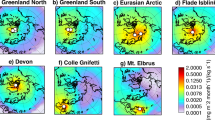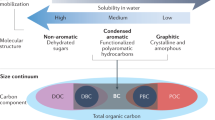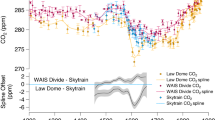Abstract
New Zealand was among the last habitable places on earth to be colonized by humans1. Charcoal records indicate that wildfires were rare prior to colonization and widespread following the 13th- to 14th-century Māori settlement2, but the precise timing and magnitude of associated biomass-burning emissions are unknown1,3, as are effects on light-absorbing black carbon aerosol concentrations over the pristine Southern Ocean and Antarctica4. Here we used an array of well-dated Antarctic ice-core records to show that while black carbon deposition rates were stable over continental Antarctica during the past two millennia, they were approximately threefold higher over the northern Antarctic Peninsula during the past 700 years. Aerosol modelling5 demonstrates that the observed deposition could result only from increased emissions poleward of 40° S—implicating fires in Tasmania, New Zealand and Patagonia—but only New Zealand palaeofire records indicate coincident increases. Rapid deposition increases started in 1297 (±30 s.d.) in the northern Antarctic Peninsula, consistent with the late 13th-century Māori settlement and New Zealand black carbon emissions of 36 (±21 2 s.d.) Gg y−1 during peak deposition in the 16th century. While charcoal and pollen records suggest earlier, climate-modulated burning in Tasmania and southern Patagonia6,7, deposition in Antarctica shows that black carbon emissions from burning in New Zealand dwarfed other preindustrial emissions in these regions during the past 2,000 years, providing clear evidence of large-scale environmental effects associated with early human activities across the remote Southern Hemisphere.
This is a preview of subscription content, access via your institution
Access options
Access Nature and 54 other Nature Portfolio journals
Get Nature+, our best-value online-access subscription
$29.99 / 30 days
cancel any time
Subscribe to this journal
Receive 51 print issues and online access
$199.00 per year
only $3.90 per issue
Buy this article
- Purchase on Springer Link
- Instant access to full article PDF
Prices may be subject to local taxes which are calculated during checkout



Similar content being viewed by others
Data availability
Data that support the findings of this study are available from the US Antarctic Program Data Center (https://doi.org/10.15784/601464).
Code availability
The FLEXPART model used in this study is available at https://www.flexpart.eu/.
References
Wilmshurst, J. M., Hunt, T. L., Lipo, C. P. & Anderson, A. J. High-precision radiocarbon dating shows recent and rapid initial human colonization of East Polynesia. Proc. Natl Acad. Sci. USA 108, 1815–1820 (2011).
McWethy, D. B. et al. Rapid landscape transformation in South Island, New Zealand, following initial Polynesian settlement. Proc. Natl Acad. Sci. USA 107, 21343–21348 (2010).
Walter, R., Buckley, H., Jacomb, C. & Matisoo-Smith, E. Mass migration and the Polynesian settlement of New Zealand. J. World Prehistory 30, 351–376 (2017).
Remer, L. A. et al. Global aerosol climatology from the MODIS satellite sensors. J. Geophys. Res. Atmos. 113, D14S07 (2008).
Stohl, A., Forster, C., Frank, A., Seibert, P. & Wotawa, G. Technical note: the Lagrangian particle dispersion model FLEXPART version 6.2. Atmos. Chem. Phys. 5, 2461–2474 (2005).
Moreno, P. I. et al. Southern Annular Mode-like changes in southwestern Patagonia at centennial timescales over the last three millennia. Nat. Commun. 5, 4375 (2014).
Fletcher, M.-S. et al. Centennial-scale trends in the Southern Annular Mode revealed by hemisphere-wide fire and hydroclimatic trends over the past 2400 years. Geology 46, 363–366 (2018).
Hamilton, D. S. et al. Reassessment of pre-industrial fire emissions strongly affects anthropogenic aerosol forcing. Nat. Commun. 9, 3182 (2018).
Liu, P. et al. Improved estimates of preindustrial biomass burning reduce the magnitude of aerosol climate forcing in the Southern Hemisphere. Sci. Adv. 7, eabc1379 (2021).
Carslaw, K. S. et al. Large contribution of natural aerosols to uncertainty in indirect forcing. Nature 503, 67–71 (2013).
Carslaw, K. S. et al. Aerosols in the pre-industrial atmosphere. Curr. Clim. Change Rep. 3, 1–15 (2017).
Matsui, H. et al. Anthropogenic combustion iron as a complex climate forcer. Nat. Commun. 9, 1593 (2018).
Moore, C. M. et al. Processes and patterns of oceanic nutrient limitation. Nat. Geosci. 6, 701–710 (2013).
Marlon, J. R. et al. Climate and human influences on global biomass burning over the past two millennia. Nat. Geosci. 1, 697–702 (2008).
McConnell, J. R. et al. 20th-century industrial black carbon emissions altered arctic climate forcing. Science 317, 1381–1384 (2007).
Arienzo, M. M. et al. Holocene black carbon in Antarctica paralleled Southern Hemisphere climate. J. Geophys. Res. Atmos. 122, 6713–6728 (2017).
McConnell, J. et al. Synchronous volcanic eruptions and abrupt climate change ~17.7 ka plausibly linked by stratospheric ozone depletion. Proc. Natl Acad. Sci. USA 114, 10035–10040 (2017).
Sigl, M. et al. The WAIS Divide deep ice core WD2014 chronology - Part 2: annual-layer counting (0–31 ka BP). Clim. Past 12, 769–786 (2016).
Eckhardt, S. et al. Source-receptor matrix calculation for deposited mass with the Lagrangian particle dispersion model FLEXPART v10.2 in backward mode. Geophys. Model Dev. 10, 4605–4618 (2017).
van Marle, M. J. E. et al. Historic global biomass burning emissions for CMIP6 (BB4CMIP) based on merging satellite observations with proxies and fire models (1750–2015). Geosci. Model Dev. 10, 3329–3357 (2017).
Iglesias, V. & Whitlock, C. Fire responses to postglacial climate change and human impact in northern Patagonia (41–43 S). Proc. Natl Acad. Sci. USA 111, E5545 (2014).
Neukom, R. et al. Multiproxy summer and winter surface air temperature field reconstructions for southern South America covering the past centuries. Clim. Dyn. 37, 35–51 (2011).
Mundo, I. A. et al. Fire history in southern Patagonia: human and climate influences on fire activity in Nothofagus pumilio forests. Ecosphere 8, e01932 (2017).
Stahle, L. N., Whitlock, C. & Haberle, S. G. A 17,000-year-long record of vegetation and fire from Cradle Mountain National Park, Tasmania. Front. Ecol. Evolut. 4, 82 (2016).
McWethy, D. B., Whitlock, C., Wilmshurst, J. M., McGlone, M. S. & Li, X. Rapid deforestation of South Island, New Zealand, by early Polynesian fires. The Holocene 19, 883–897 (2009).
Mudelsee, M. Break function regression. Eur. Phys. J. Special Topics 174, 49–63 (2009).
Liu, T. et al. Diagnosing spatial biases and uncertainties in global fire emissions inventories: Indonesia as regional case study. Remote Sensing Environ. 237, 111557 (2020).
Perry, G. L. W., Wilmshurst, J. M. & McGlone, M. S. Ecology and long-term history of fire in New Zealand. New Zealand J. Ecol. 38, 157–176 (2014).
Mulvaney, R. et al. Recent Antarctic Peninsula warming relative to Holocene climate and ice-shelf history. Nature 489, 141–144 (2012).
Abram, N. J. et al. Acceleration of snow melt in an Antarctic Peninsula ice core during the twentieth century. Nat. Geosci. 6, 404–411 (2013).
McConnell, J. R., Aristarain, A. J., Banta, J. R., Edwards, P. R. & Simoes, J. C. 20th-century doubling in dust archived in an Antarctic Peninsula ice core parallels climate change and desertification in South America. Proc. Natl Acad. Sci. USA 104, 5743–5748 (2007).
McConnell, J. R. et al. Antarctic-wide array of high-resolution ice core records reveals pervasive lead pollution began in 1889 and persists today. Sci. Rep. 4, 5848 (2014).
Sigl, M. et al. Insights from Antarctica on volcanic forcing during the Common Era. Nat. Clim. Change 4, 693–697 (2014).
Bisiaux, M. M. et al. Variability of black carbon deposition to the East Antarctic Plateau, 1800–2000 AD. Atmos. Chem. Phys. 12, 3799–3808 (2012).
Bisiaux, M. M. et al. Changes in black carbon deposition to Antarctica from two high-resolution ice core records, 1850–2000 AD. Atmos. Chem. Phys. 12, 4107–4115 (2012).
McConnell, J. R. Continuous ice-core chemical analyses using inductively coupled plasma mass spectrometry. Environ. Sci. Technol. 36, 7–11(2002).
McConnell, J. et al. Lead pollution recorded in Greenland ice indicates European emissions tracked plagues, wars, and imperial expansion during antiquity. Proc. Natl Acad. Sci. USA 115, 5726–5731 (2018).
Sigl, M. et al. Timing and climate forcing of volcanic eruptions for the past 2,500 years. Nature 523, 543–549 (2015).
O’Hare, P. et al. Multiradionuclide evidence for an extreme solar proton event around 2,610 BP (similar to 660 BC). Proc. Natl Acad. Sci. USA 116, 5961–5966 (2019).
Arienzo, M. et al. A method for continuous (PU)-P-239 determinations in Arctic and Antarctic ice cores. Environ. Sci. Technol. 50, 7066–7073 (2016).
McConnell, J. R. et al. Extreme climate after massive eruption of Alaska’s Okmok volcano in 43 BC and its effects on the civil wars of the late Roman Republic. Proc. Natl Acad. Sci. USA 117, 15443–15449 (2020).
Narcisi, B., Petit, J. R., Delmonte, B., Basile-Doelsch, I. & Maggi, V. Characteristics and sources of tephra layers in the EPICA-Dome C ice record (East Antarctica): Implications for past atmospheric circulation and ice core stratigraphic correlations. Earth Planet. Sci. Lett. 239, 253–265 (2005).
Basile, I., Petit, J. R., Touron, S., Grousset, F. E. & Barkov, N. Volcanic layers in Antarctic (Vostok) ice cores: source identification and atmospheric implications. J. Geophys. Res. Atmos. 106, 31915–31931 (2001).
Castellano, E. et al. Volcanic eruption frequency over the last 45 ky as recorded in Epica-Dome C ice core (East Antarctica) and its relationship with climatic changes. Global Planet. Change 42, 195–205 (2004).
Cole-Dai, J. et al. Comprehensive record of volcanic eruptions in the Holocene (11,000 years) from the WAIS divide, Antarctica ice core. J. Geophys. Res. Atmos. 126, e2020JD032855 (2021).
Laloyaux, P., de Boisseson, E. & Dahlgren, P. CERA-20C: an Earth system approach to climate reanalysis. ECMWF Newsletter 150, 25–30 (2017).
van der Werf, G. R. et al. Global fire emissions and the contribution of deforestation, savanna, forest, agricultural, and peat fires (1997–2009). Atmos. Chem. Phys. 10, 11707–11735 (2010).
Hoesly, R. M. et al. Historical (1750–2014) anthropogenic emissions of reactive gases and aerosols from the Community Emissions Data System (CEDS). Geosci. Model Dev. 11, 369–408 (2018).
Le Bas, M. J., Le Maitre, R. W., Streckeisen, A., Zanettin, B. & IUGS Subcommission on the Systematics of Igneous Rocks Chemical classification of volcanic rocks based on the total alkali-silica diagram. J. Petrol. 27, 745–750 (1986).
Palais, J. M., Kyle, P. R., Mosley-Thompson, E. & Thomas, E. Correlation of a 3,200 year old tephra in ice cores from Vostok and South Pole Stations, Antarctica. Geophys. Res. Lett. 14, 804–807 (1987).
Kyle, P. R., Palais, J. & Thomas, E. The Vostok tephra – an important englacial stratigraphic marker? Antarctic J. 19, 64–65 (1984).
Acknowledgements
National Science Foundation (NSF) grants 0538416, 0968391, 1702830, 1832486 and 1925417 to J.R.M. funded this research, with internal funding provided by DRI for laboratory analyses of B53, B54 and the two JRI cores. Additional funding from NSF 1702814 supported P.L. and Swiss National Science Foundation grant P400P2_199285 supported S.O.B. We thank all the British, French, Argentine, German, Norwegian, Australian and American field teams for their efforts, as well as students and staff in the DRI ice-core group for assistance in the laboratory.
Author information
Authors and Affiliations
Contributions
J.R.M. designed the study, with contributions from N.J.C., A.S., G.P., D.B.M. and P.L. J.R.M., R.M, S.K., E.I., A.J.A., N.J.A. and D.B.M. provided ice samples and previous measurements. J.R.M., N.J.C., R.M., G.P., S.K., J.F., K.E.G. and S.O.B. conducted and analysed measurements. R.M., S.E. and P.L. conducted model simulations. J.R.M., N.J.C., A.S., G.P. and D.B.M. led the writing of the manuscript and all other co-authors contributed. A.J.A. is retired from the Instituto Antártico Argentino.
Corresponding author
Ethics declarations
Competing interests
The authors declare no competing interests.
Additional information
Peer review information Nature thanks Patrick Kirch and the other, anonymous, reviewer(s) for their contribution to the peer review of this work. Peer reviewer reports are available.
Publisher’s note Springer Nature remains neutral with regard to jurisdictional claims in published maps and institutional affiliations.
Extended data figures and tables
Extended Data Fig. 1 rBC measured in the Antarctic ice-core array.
a, b, JRI records used to represent the nAP. rBC measurements of the JRI_D98 record (red) from 2007 confirm 2016 measurements in the JRI_2008 core (black) (Methods). c–g, The B40 and scaled NUS08_7 records were averaged to create a DML regional composite. h–l, The B53 and scaled NUS07_7 cores were combined to create an iEAP regional composite. Shown are annual (light) and 11-year geometric mean filtered (heavy) fluxes.
Extended Data Fig. 2 FLEXPART-simulated emission sensitivities.
a, nAP. b, iEAP. c, nAP/iEAP. d, nAP-iEAPscaled, where the iEAP scaler of 10.1 is the average nAP/iEAP ratio in the ice cores from 900 to 1200. Insets show values for New Zealand and crosses mark ice-core locations. The maps were made using Python.
Extended Data Fig. 3 Repeatability of the rBC measurements in ice.
Comparisons of original 2013 and selected replicate 2016 rBC measurements in the B40 ice core. a, b, Parallel B40 samples either from shallower firn (a) and deeper ice (b) were measured at the start of each day to monitor any changes in calibrations or instrument responses during the 2016 analysis of the JRI_2008 core.
Extended Data Fig. 4 Example of annual layer counting of the JRI_2008 core.
Corresponding years are shown along the top. Previous high-resolution measurements extended only to 130 m so annual layer counted ended at ~180730. Here we extended annual layer counting to ~300 m or ~1,000 using new high-resolution elemental and chemical measurements over the full 363.9-m depth.
Extended Data Fig. 5 Evaluation of ice-core chronology consistency using sulfur fallout from explosive volcanism.
a–e, Annually averaged sulfur concentrations during the 12th through 18th century in the five longer ice cores in the Antarctic rBC array. The average of the four continental cores (b–e) is shown in light grey for perspective. Also shown are tie points for this time range used to constrain annual layer counting and ice flow modelling in the JRI_2008 record.
Extended Data Fig. 6 Revised chronology for the JRI_2008 ice core.
a, The chronology (black solid) is consistent with the WD2014 age scale and based on annual layer counting (red dashed) from the surface to ~275 m (2008 to 1257 CE) and ice flow modelling from ~275 m to the bottom. Flow modelling is constrained by 12 depth-age control points (diamonds) including the 3568 yBP Vostok tephra at 345.43 m also found in East Antarctic cores. Control points below 350-m depth are 358.627 m, 11988 yBP; 358.785 m, 12800 yBP; and 359.000 m, 14607 yBP). b, Water flux.
Extended Data Fig. 7 Total alkali silica plot49.
Tephra shards extracted from 345.43 m in the JRI_2008 core are geochemically matched to the Vostok tephra previously reported in a number of cores from Vostok42,50,51, South Pole51 and Dome Concordia43. Geochemical fields are based on Narcisi and colleagues 42. We determined an eruption date of 3568 yBP on the WD2014 age scale by synchronizing high-resolution sulfate measurements to continuous sulfate measurements in WAIS Divide.
Supplementary information
Rights and permissions
Springer Nature or its licensor (e.g. a society or other partner) holds exclusive rights to this article under a publishing agreement with the author(s) or other rightsholder(s); author self-archiving of the accepted manuscript version of this article is solely governed by the terms of such publishing agreement and applicable law.
About this article
Cite this article
McConnell, J.R., Chellman, N.J., Mulvaney, R. et al. Hemispheric black carbon increase after the 13th-century Māori arrival in New Zealand. Nature 598, 82–85 (2021). https://doi.org/10.1038/s41586-021-03858-9
Received:
Accepted:
Published:
Issue Date:
DOI: https://doi.org/10.1038/s41586-021-03858-9
This article is cited by
-
Revised historical Northern Hemisphere black carbon emissions based on inverse modeling of ice core records
Nature Communications (2023)
-
Black carbon footprint of human presence in Antarctica
Nature Communications (2022)
-
Black carbon attribution
Nature (2022)
-
Reply to: Black carbon attribution
Nature (2022)
Comments
By submitting a comment you agree to abide by our Terms and Community Guidelines. If you find something abusive or that does not comply with our terms or guidelines please flag it as inappropriate.



